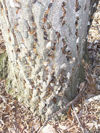Gypsy moth
| Gypsy moth |
|---|

|
| Scientific Classification |
|
| Binomial Name |
| Lymantria dispar |
| Antenna of a gypsy moth |

|
The gypsy moth is one of the most well known pests of hardwood trees. The gypsy moth has defoliated around a million forested acres every year. A record of 12.9 million acres was destroyed by the gypsy in 1981.[1]
Anatomy
Adult Gypsy Moths bodies are covered entirely by hair. Female Gypsy’s have a normal wingspan of about 2 in. The Gypsy moth is native to Europe and Asia. In the Asian variety are white and have dark lines going down there wings. Smaller male Gypsy Moths are gray. In order to keep eggs warm the female will cover the eggs with her warm, hairy body. The eggs hatch and the larvae come out in the spring. The larvae have black bodies and yellow stripes. When they are fully grown they are around 2 inches in length. They are in there pupa for around two weeks before they finally emerge in the middle of the summer.
The European Gypsy Moths are not able to fly. Caterpillars allow the wind to carry them onto vehicles or to other places in order for them to be able to spread out. [2]
Reproduction
During the yearly cycle of the gypsy moth most of its time is spent in the egg stage. The time spent in the egg stage usually runs from August to April although the weather can have an effect on the egg making it hatch sooner or later. Eggs are laid within 24 hours of mating although the process could take up to several days. The eggs are usually laid next to the females pupa casing because the female is not able to fly. A normal individual egg mass contains anywhere from 100 to 1,200 eggs. The average of eggs produced depends on the health of the population. The hatching of the eggs is usually started by the warmth of spring and once started the rest of the eggs will hatch within a week. The larval stage goes from May to July. The larva when first having hatched are only about a 1/8 of an inch in length while when they are fully grown the can become up to 2 to 3 inches in length. The newly hatched larva will sit on egg mass in wet cool weather. Sometimes an egg mass can be seen being covered by hundreds of larvae. They then move up into a tree and leave a small thread of silk behind them allowing the wind to lift and carry them through the air to another location. The process is called ballooning and it is how the gypsy moth has been able to spread itself out to many different locations. When the larval stage has been completed the last larval skin is shed and within an hour it will turn from a white to a brown. The process of transformation takes around two weeks and the adult merges in mid July and early August. When it is an adult, immediately after it emerges from the cocoon, it is able to reproduce. The adult form's lifespan is only a week because it does not eat. [3]
Ecology
The effects that the gypsy moths have on the environment is fairly severe. Then are known for defoliating oak, aspen, and other trees in North Central United States. Since 1869, gypsy moth populations have grown much larger and spread through Pennsylvania and Michigan and even south to North Carolina. Gypsy moth outbreaks can last for long periods of time, normally from 1 to 5 years. After an outbreak the population steadily decreases until the next outbreak. Normally, defoliation is most severe during the first outbreak in an newly infested area. If more than 60% of the trees leaves are consumed by gypsy moth caterpillars then the tree will produce more leaves typically later on in the summer. Trees during the years of defoliation usually effect the diameter growth on the trees. Defoliation can also reduce a trees seed production and its sprouting of roots which means that there will be poor regeneration of the trees. [4]
Natural Enemies of the Gypsy Moth
The gypsy moth has many natural enemies and without them our forest would be in worse shape then they are today. Their natural enemies are parasitic and predatory insects such as wasps, flies, ground beetles and ants. Also many birds are predators of the gypsy moth such as chickadees, blue jays, nuthatches, towhees, and robins. There are even some mammals that are enemies of the gypsy moth such as the white-footed mouse, shrews, chipmunks, squirrels, and raccoons. The largest source of killers of the gypsy is mice and shrews. Without them there could very possibly be more outbreaks. The enemies of the gypsy moth help in keeping the outbreaks to a minimum. [5]
 Browse |
References
- Semiochemicals of Lymantria obfuscata, the Indian gypsy moth Beroza, Beroza, M., Punjabi, A.A., and Bierl, B.A. 1973b. Disparlure and analogues as attractants for Lymantria obfuscata. J. Econ. Entomol. 66:1215-1216.
- Gypsy moth Encyclopedia.
- Gypsy moth lifecycle Department of Agriculture.
- Gypsy moth in the forest Michigan State University Department of Entomology, Gypsy Moth Education Program.
- Gypsy moth Many authors.


